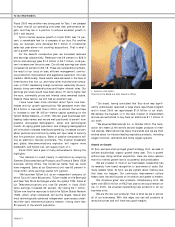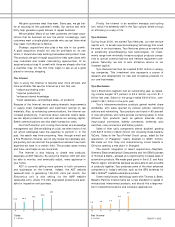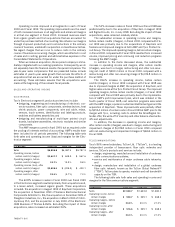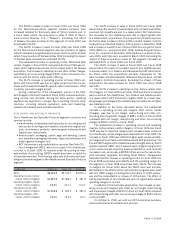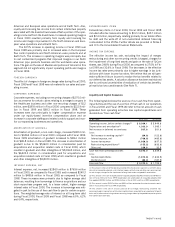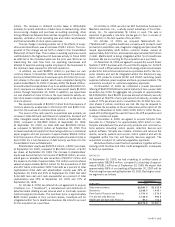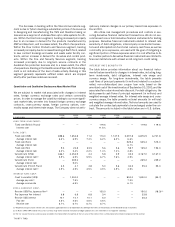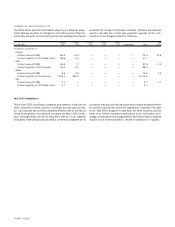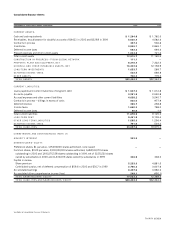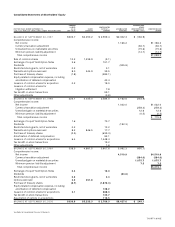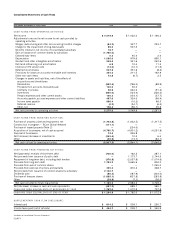ADT 2000 Annual Report Download - page 32
Download and view the complete annual report
Please find page 32 of the 2000 ADT annual report below. You can navigate through the pages in the report by either clicking on the pages listed below, or by using the keyword search tool below to find specific information within the annual report.
THIRTY
In addition, in Fiscal 2000 and Fiscal 1999 we paid out $544.2
million and $354.4 million, respectively, in cash that was charged
against reserves established in connection with acquisitions
accounted for under the purchase accounting method. This amount
is included in “Acquisition of businesses, net of cash acquired” in
the Consolidated Statement of Cash Flows.
Business combinations are accounted for either on a pooling of
interests basis or under the purchase accounting method. In Fiscal
1999, the Company made two business combinations, USSC and
AMP, that were required to be accounted for on a pooling of inter-
ests basis. Under pooling of interests accounting, the merged com-
panies are treated as if they had always been part of Tyco, and their
financial statements are included in our Consolidated Financial
Statements for all periods presented.
At the time of each pooling of interests transaction, Tyco estab-
lishes a reserve for transaction costs and the costs that we expect to
incur in integrating the merged company within the relevant Tyco
business segment. By integrating merged companies with our exist-
ing businesses, we expect to realize operating synergies and long-
term cost savings. Integration costs, which relate primarily to
termination of employees and the closure of facilities made
redundant, are detailed in Note 16 to the Consolidated Financial
Statements. Reserves for merger, restructuring and other non-
recurring items are taken as a charge against current earnings at the
time the reserves are established. Amounts expended for merger,
restructuring and other non-recurring costs are charged against the
reserves as they are paid out. If the amount of the reserves proves
to be greater than the costs actually incurred, any excess is credited
against merger, restructuring and other non-recurring charges in the
Consolidated Statement of Operations in the period in which that
determination is made.
In Fiscal 2000, we established merger, restructuring and other
non-recurring reserves of $325.2 million, of which $7.3 million is
included in cost of sales, primarily related to a reserve for certain
claims relating to a merged company in the Healthcare business,
the restructuring activities in AMP’s Brazilian operations and wire-
less communications business, a non-recurring charge incurred in
connection with the TyCom IPO, charges associated with USSC’s
suture business and the exiting of USSC’s interventional cardiology
business. At the beginning of the fiscal year, there existed merger,
restructuring and other non-recurring reserves of $399.3 million
related to pooling of interests transactions consummated in prior
years and other restructuring charges taken by the merged compa-
nies prior to their combination with Tyco. During Fiscal 2000, we
paid out $155.2 million in cash and incurred $54.5 million in non-
cash charges that were charged against these reserves. Also in Fis-
cal 2000, we determined that $148.9 million of merger,
restructuring and other non-recurring reserves established in prior
years were not needed. These amounts were taken as merger,
restructuring and other non-recurring credits during Fiscal 2000
and offset against the reserves. At September 30, 2000, there
remained $365.9 million of merger, restructuring and other non-
recurring reserves on our Consolidated Balance Sheet, of which
$334.8 million is included in current liabilities and $31.1 million is
included in long-term liabilities.
All business combinations completed in Fiscal 2000 were
required to be accounted for under the purchase accounting
method. At the time each purchase acquisition is made, we estab-
lish a reserve for transaction costs and the costs of integrating the
purchased company within the relevant Tyco business segment. The
amounts of such reserves established in Fiscal 2000 are detailed in
Note 3 to the Consolidated Financial Statements. These amounts
are not charged against current earnings but are treated as
additional purchase price consideration and have the effect of
increasing the amount of goodwill recorded in connection with the
respective acquisition. We view these costs as the equivalent of
additional purchase price consideration when we consider making
an acquisition. If the amount of the reserves proves to be in excess
of costs actually incurred, any excess is used to reduce the goodwill
account that was established at the time the acquisition was made.
In Fiscal 2000, we made acquisitions that were accounted for
under the purchase accounting method at an aggregate cost of
$5,162.0 million. Of this amount, $4,246.5 million was paid in cash
(net of cash acquired), $671.4 million was paid in the form of Tyco
common shares, and we assumed $244.1 million in debt. In con-
nection with these acquisitions, we established purchase account-
ing reserves of $426.2 million for transaction and integration costs.
At the beginning of Fiscal 2000, purchase accounting reserves were
$570.3 million as a result of purchase accounting transactions
made in prior years. During Fiscal 2000, we paid out $544.2 million
in cash and incurred $52.1 million in non-cash charges against the
reserves established during and prior to Fiscal 2000. Also in Fiscal
2000, we determined that $117.8 million of purchase accounting
reserves related to acquisitions made prior to Fiscal 2000 were not
needed and reversed that amount against goodwill. At September
30, 2000, there remained $372.6 million in purchase accounting
reserves on our Consolidated Balance Sheet, of which $349.2 mil-
lion is included in current liabilities and $23.4 million is included
in long-term liabilities.
The following details the Fiscal 2000 capital expenditures and
depreciation by segment:
CAPITAL
(I N MILLI ONS) EXPENDITURES DEPRECIATION
Electronics $ 2 9 3 . 8 $ 4 4 4 .9
Telecommunications 3 1 6 .0 (1 ) 5 7 .4
Healthcare and Specialty Products 2 5 1 .1 1 9 2 .8
Fire and Security Services 7 6 4 .3 3 0 9 .4
Flow Control Products and Services 1 4 2 .1 8 2 .9
Corporate 4 7 .6 7 .6
$ 1 ,8 1 4 .9 $ 1 ,0 9 5 .0
(1) Includes $111.1 million in spending for construction of the TyCom Global Network.
We continue to fund capital expenditures to improve the cost
structure of our businesses, to invest in new processes and technol-
ogy, and to maintain high quality production standards. The level of
capital expenditures for the Fire and Security Services segment sig-
nificantly exceeded, and is expected to continue to significantly
exceed, depreciation due to the large volume growth of new residen-
tial subscriber systems capitalized. The level of capital expenditures
in the Telecommunications segment is expected to significantly
increase due to construction of the TyCom Global Network. The level
of capital expenditures in the other segments is expected to increase
moderately in Fiscal 2001. The source of funds for capital expendi-
tures is expected to be cash from operating activities.
The provision for income taxes in the Consolidated Statement
of Operations for Fiscal 2000 was $1,926.0 million, but the amount
of income taxes paid (net of refunds) during the year was $454.7
million. The difference is due primarily to the timing of tax payments
related to the gain on issuance of shares by TyCom. The current
income tax liability at September 30, 2000 was $1,650.3 million,
as compared to $798.0 million at September 30, 1999. After
adjustment for deferred income taxes of acquired companies and
other items, the net increase in deferred income taxes was $507.8


